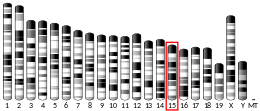LYNX1
Ly6/neurotoxin 1 is a protein in humans that is encoded by the LYNX1 gene.[5] Alternatively spliced variants encoding different isoforms have been identified.
Function
This gene encodes a member of the Ly-6/neurotoxin gene family, a group of lymphocyte antigens that attach to the cell surface by a glycosylphosphatidylinositol anchor and have a unique structure showing conserved 8-10 cysteine residues with a characteristic spacing pattern. Functional analysis indicates that this protein is not a ligand or neurotransmitter but has the capacity to enhance nicotinic acetylcholine receptor function in the presence of acetylcholine. This gene may also play a role in the pathogenesis of psoriasis vulgaris.[5]
The LYNX1 gene codes for a protein (Lynx1) that binds to acetylcholine receptors in the brain.[6] Lynx1 a member of the Ly6 superfamily of proteins that are capable of modulating neurotransmitter receptors.[7]
Lynx1 and Visual Plasticity
Transgenic mice without Lynx1 expression do not have a normal critical period of neuroplasticity in the visual cortex for development of ocular dominance columns.[8] These mice show unusually rapid recovery from amblyopia in adulthood indicating a role in reduction of synaptic plasticity during the normal expression of Lynx1 in adult brain.[6]
Lynx1 reduces adult visual cortex plasticity by binding to nicotinic acetylcholine receptors (NAchR) and diminishing acetylcholine signaling.[9] After the developmental critical period and into adulthood, both Lynx1 mRNA and protein levels increase in the adult V1 and the lateral geniculate nucleus (LGN).[9] Lynx1 and nAChR mRNAs are co-expressed in the LGN, as well as in parvalbumin-positive GABAergic interneurons.[9] After monocular deprivation during the critical period to induce amblyopia, Lynx1 knock-out rat models spontaneously recovered normal visual acuity by reopening the closed eye.[9] Similarly, an infusion of physostigmine to increase acetylcholine signaling prompted recovery from amblyopia in wild type mice[9] Inhibition of Lynx1 may be a possible therapeutic mechanism to prolong synaptic plasticity of the visual cortex and improve binocular function of some amblyopes.
See also
Other Ly6 family proteins that are expressed in the brain: Lynx2, LYPD6, LYPD6B and PSCA.[6]
References
- GRCh38: Ensembl release 89: ENSG00000180155 - Ensembl, May 2017
- GRCm38: Ensembl release 89: ENSMUSG00000022594 - Ensembl, May 2017
- "Human PubMed Reference:". National Center for Biotechnology Information, U.S. National Library of Medicine.
- "Mouse PubMed Reference:". National Center for Biotechnology Information, U.S. National Library of Medicine.
- "Entrez Gene: Ly6/neurotoxin 1".
- Miwa JM, Lester HA, Walz A (Aug 2012). "Optimizing cholinergic tone through lynx modulators of nicotinic receptors: implications for plasticity and nicotine addiction". Physiology. 27 (4): 187–99. doi:10.1152/physiol.00002.2012. PMID 22875450.
- Holford M, Auer S, Laqua M, Ibañez-Tallon I (2009). "Manipulating neuronal circuits with endogenous and recombinant cell-surface tethered modulators". Frontiers in Molecular Neuroscience. 2: 21. doi:10.3389/neuro.02.021.2009. PMC 2776481. PMID 19915728.
- Higley MJ, Strittmatter SM (Nov 2010). "Neuroscience. Lynx for braking plasticity". Science. 330 (6008): 1189–90. doi:10.1126/science.1198983. PMC 3244692. PMID 21109660.
- Morishita H, Miwa JM, Heintz N, Hensch TK (Nov 2010). "Lynx1, a cholinergic brake, limits plasticity in adult visual cortex". Science. 330 (6008): 1238–40. doi:10.1126/science.1195320. PMC 3387538. PMID 21071629.
This article incorporates text from the United States National Library of Medicine, which is in the public domain.



